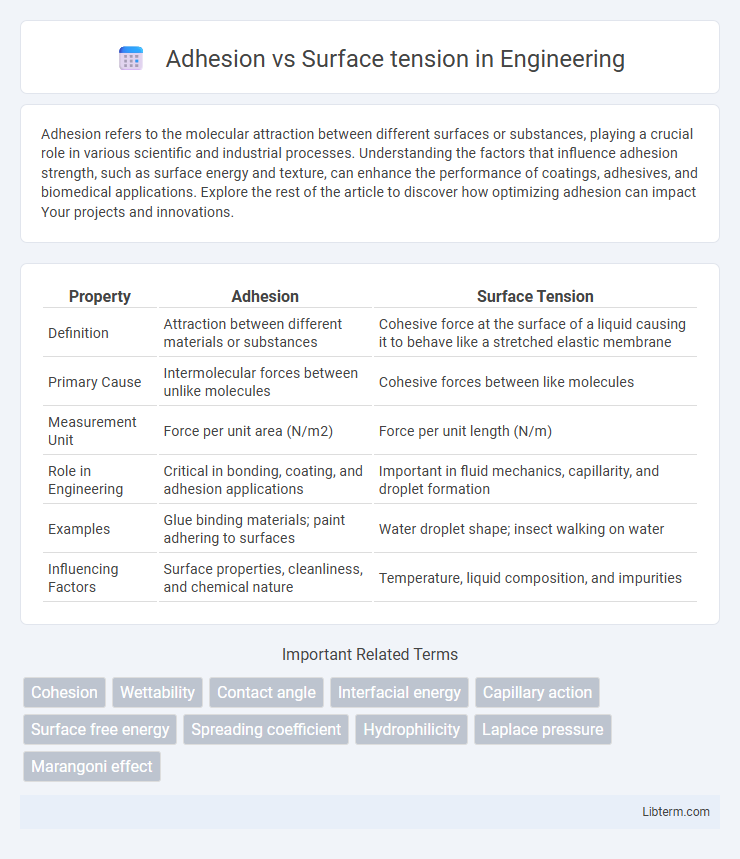Adhesion refers to the molecular attraction between different surfaces or substances, playing a crucial role in various scientific and industrial processes. Understanding the factors that influence adhesion strength, such as surface energy and texture, can enhance the performance of coatings, adhesives, and biomedical applications. Explore the rest of the article to discover how optimizing adhesion can impact Your projects and innovations.
Table of Comparison
| Property | Adhesion | Surface Tension |
|---|---|---|
| Definition | Attraction between different materials or substances | Cohesive force at the surface of a liquid causing it to behave like a stretched elastic membrane |
| Primary Cause | Intermolecular forces between unlike molecules | Cohesive forces between like molecules |
| Measurement Unit | Force per unit area (N/m2) | Force per unit length (N/m) |
| Role in Engineering | Critical in bonding, coating, and adhesion applications | Important in fluid mechanics, capillarity, and droplet formation |
| Examples | Glue binding materials; paint adhering to surfaces | Water droplet shape; insect walking on water |
| Influencing Factors | Surface properties, cleanliness, and chemical nature | Temperature, liquid composition, and impurities |
Introduction to Adhesion and Surface Tension
Adhesion refers to the molecular attraction between different substances, such as water molecules bonding with a glass surface, which enables phenomena like capillary action. Surface tension arises from cohesive forces between similar molecules at a liquid's surface, creating a "skin-like" effect that resists external force. Both adhesion and surface tension impact fluid behavior, influencing wetting, spreading, and the formation of droplets on various materials.
Defining Adhesion: Basic Concepts
Adhesion refers to the attractive force between different substances, such as water molecules and a glass surface, causing them to cling together. This force arises from molecular interactions like hydrogen bonding, van der Waals forces, or electrostatic attraction at the interface. Understanding adhesion is crucial for applications in coating, painting, and biological systems where surface contact plays a vital role.
Surface Tension Explained
Surface tension is the cohesive force at the surface of a liquid that causes it to behave like a stretched elastic membrane, resulting from molecular attraction between liquid molecules. This phenomenon allows liquids to resist external force, enabling droplets to form and small objects to float on the surface without sinking. Surface tension is measured in force per unit length (N/m) and varies with temperature and liquid type, playing a crucial role in processes like capillary action and biological functions.
Molecular Forces Behind Adhesion
Adhesion arises from intermolecular forces such as hydrogen bonding, van der Waals forces, and electrostatic interactions that occur between different substances, causing their molecules to stick together. These forces enable liquids to spread over or cling to solid surfaces, contrasting with surface tension, which is the cohesive force among like molecules at a liquid's surface. The balance between adhesive and cohesive forces determines phenomena like wetting, capillary action, and the behavior of liquids on various materials.
The Science of Surface Tension
Surface tension arises from cohesive forces between liquid molecules at the interface, creating a "skin-like" effect that minimizes surface area. Adhesion refers to the attractive forces between different substances, such as liquid molecules and solid surfaces, influencing phenomena like capillary action. The balance between adhesion and surface tension determines how liquids interact with surfaces, impacting processes in biology, engineering, and material science.
Key Differences Between Adhesion and Surface Tension
Adhesion refers to the attractive force between different substances, such as water molecules and glass, while surface tension is the cohesive force among similar molecules at a liquid's surface, causing it to behave like a stretched elastic membrane. In adhesion, the liquid molecules adhere to a solid surface, leading to phenomena like capillary action, whereas surface tension results from intermolecular forces within the liquid itself, maintaining its surface shape. Key differences lie in the interaction types--adhesion involves liquid-to-solid attraction, and surface tension involves liquid-to-liquid cohesion--affecting various applications in coatings, printing, and fluid mechanics.
Real-World Examples of Adhesion
Adhesion, the tendency of different substances to stick together, is demonstrated in real-world examples such as water droplets clinging to plant leaves or paint bonding to walls. This phenomenon contrasts with surface tension, which refers to the cohesive forces between like molecules, as seen in water forming droplets or insects walking on water surfaces. Adhesion plays a crucial role in applications like ink adhering to paper and biological processes including cell membrane interactions.
Everyday Applications of Surface Tension
Surface tension enables water droplets to form beads on surfaces such as leaves, facilitating efficient water runoff and preventing damage to plants. This property allows small insects like water striders to walk on water without sinking, using surface tension as a support mechanism. In household cleaning, surface tension influences the spreading and effectiveness of soaps and detergents on greasy or wet surfaces.
Impact of Adhesion and Surface Tension in Technology
Adhesion and surface tension critically influence the performance of coatings, adhesives, and microfluidic devices by dictating the interaction between liquids and solid surfaces. High adhesion enhances the bonding strength in adhesive technologies, ensuring durability and reliability, while surface tension governs fluid behavior in inkjet printing and lab-on-a-chip systems by controlling droplet formation and spread. Optimizing these forces enables innovations in flexible electronics, medical diagnostics, and precision manufacturing by improving material interface stability and fluid manipulation.
Conclusion: Importance in Science and Industry
Adhesion and surface tension are critical physical properties influencing fluid behavior and material interactions. Adhesion governs the attraction between different substances, essential for coating technologies, printing, and biological applications, while surface tension controls liquid surface phenomena relevant to droplet formation, capillarity, and emulsification processes. Understanding these forces allows scientists and engineers to optimize products in pharmaceuticals, manufacturing, and environmental science, enhancing efficiency and innovation.
Adhesion Infographic

 libterm.com
libterm.com